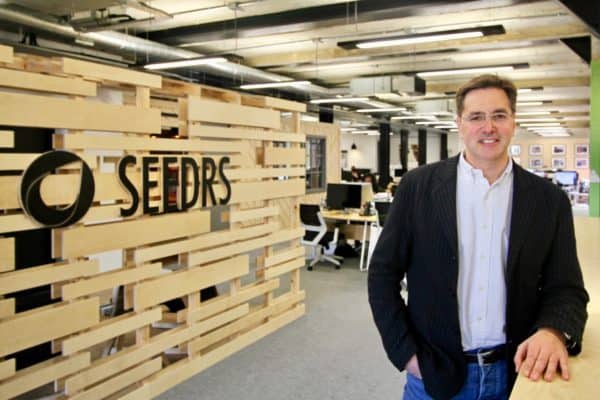
Seedrs is a trailblazer in the crowdfunding world. The UK was the first market to craft a regulatory regime that truly facilitated online capital formation for startups, scale ups, and more mature companies. The ecosystem has evolved to a point where crowdfunding is becoming the preferred option to raise capital from both retail investors and more sophisticated angels and VCs. Issuers may raise small amounts of money, like a couple hundred thousand pounds, or alternatively multi-million pound offerings.
Frequently, smaller investors can back promising companies on the same terms as VCs – which is exactly how you want the industry to evolve. Adding SEIS and EIS qualified offers (a tax exemption for investors) to the mix and the risk vs. reward paradigm becomes truly interesting. In the UK, investment crowdfunding simply works.
2017 was a period of change for Seedrs. Perhaps the two biggest events during the last twelve months was the launch of the Seedrs Secondary Market and the hiring of CEO Jeff Kelisky who replaced longtime executive and co-founder Jeff Lynn who moved into the Chairman position.
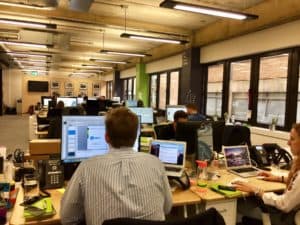 The Secondary Market, still very much an evolving marketplace, saw 682 trades during the year with some investors experiencing 19X returns. Creating an effective marketplace for these non-public securities solves a liquidity challenge that is intrinsic in most early stage investing. If you purchase securities in a company on the Seedrs platform you have a path for an exit if you need to (or want to) get out.
The Secondary Market, still very much an evolving marketplace, saw 682 trades during the year with some investors experiencing 19X returns. Creating an effective marketplace for these non-public securities solves a liquidity challenge that is intrinsic in most early stage investing. If you purchase securities in a company on the Seedrs platform you have a path for an exit if you need to (or want to) get out.
During 2017, Seedrs topped £300 million invested on the platform having funded more than 580 offerings since launch. Funding included Seedrs own £10 million self-crowdfunding round where Neil Woodford increased his stake by £4 million and approximately 2,000 Seedrs users invested a further £6 million. The self crowdfunding round was joined by many other prominent offers including digital challenger bank Revolut’s Series B offer that raised £3.8 million from over 4,300 investors as part of a £50 million Series B round led by Index Ventures.
A few days before Christmas, Crowdfund Insider had a chance to sit down with Kelisky to hear first hand his experience during his first year at Seedrs as well as his vision for the future.
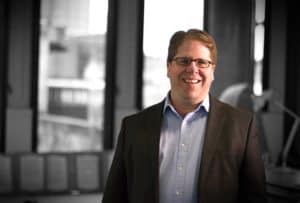 Kelisky joined Seedrs 10 months ago coming from a slightly different world of big tech and early stage scale ups. My first question for Kelisky was to ask what he felt were his biggest accomplishments during his short tenure at Seedrs. Kelisky said the launch of the Secondary Market was at the top of the list.
Kelisky joined Seedrs 10 months ago coming from a slightly different world of big tech and early stage scale ups. My first question for Kelisky was to ask what he felt were his biggest accomplishments during his short tenure at Seedrs. Kelisky said the launch of the Secondary Market was at the top of the list.
Kelisky explained that one of the reason’s the Secondary Market works so well is the Nominee Structure that all crowdfunding offers must utilize if they list on Seedrs.
In brief, the Nominee Structure creates is a single shareholder on the cap table. This makes it easy to manage decisions that require a vote plus all of the additional bureaucratic demands in managing investors. Seedrs continues to hold the shares as the nominee and does not wash its hands of the investment after a deal closes. This also helps to align the interests of the platform with the investors.
Speaking about the Nominee Structure Kelisky indicated this took exceptional foresight on Lynn’s part. This is an area where Lynn got things right;
“I think one of the interesting things about [the Nominee Structure], in many ways, is the benefit of things that [Jeff Lynn] did that were not immediately understood. In starting a company, when you don’t have a lot of cash there are things you have to get right. Jeff had some gold nuggets. Jeff has been really good in getting us here.”
The Secondary Market is key to Seedrs growth. They have effectively built a capability to automate the transaction of the secondary trades and do it in a way that works with the Nominee structure. They can execute a trade within 24 hours instead of dealing with every single investor. This is fundamentally scalable. Launched in June, the Secondary Market quickly accepted 130 lots and 40% were sold in 2 hours.
“We have had shy of half a dozen company exits but now we have had 100s of investor exits with our Secondary Market. Test. Learn and iterate,” explains Kelisky. “There are a number of new features on the way.”
At the moment, the Seedrs Secondary Market is only for investors in the Nominee providing transactions up to 1000 pounds and no auction. As Seedrs moves forward they will start to open up those gates. The biggest one is buying and selling outside the Nominee. They will also provide access to the institutional market. That is huge.
Kelisky believes public markets are mature and, frankly stagnating. He says if we had talked about investment crowdfunding in 2012 we may have said this is where you go when everyone else has said no. Today, that is simply not the case. They are moving beyond venture capital. They are talking to other institutional money like family offices who want to invest in Seedrs listed offers.
“Today, we are the place where the crowd meets with big name VCs. We are now moving beyond the VC, engaged in family office conversations and institutions that are very forward looking. In some cases it is very tax driven. Or in other cases it is thesis driven like Health Care or Education. [Crowdfunding] has opened up a window on what is happening on the inside,” says Kelisky.
It is rare to have an early stage company that generates a profit. It is more about growth and carving out market share – something that takes a lot of time. Seedrs is no exception in this area but I had to ask when will the crowdfunding platform become profitable?
“We have a structured path that takes us to profitability. Next year and the following year are investment years. We are expanding the development team and the sales and marketing team and harnessing some of these elements that have been built. We are not looking to be profitable in 2018. Full year of profitably will be by 2020. There is a plan behind that,” shares Kelisky.
The crowdfunding market in the UK is maturing rapidly and is recognized by many as the future of capital formation. I asked Kelisky what Seedrs has in the pipeline for 2018.
“Deal flow. For 2018 I do see deal flow continuing to grow at this pace. There is a 6 month plus productivity for a sales team. New sales and marketing folks ramp up. That takes time. The team has done a tremendous job but we have grown the size of the team. I do not see too much challenge in the deal flow growth.”
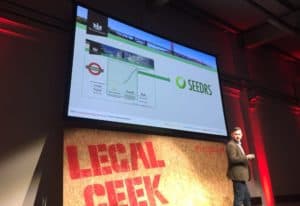 Kelisky adds there will be more partnerships coming similar to the arrangement made with the Law Society that represents over 136,000 attorneys in the UK. These members are very much interested in backing startups in the Legaltech space. Lawyers understand this and they want to curate Legaltech deal flow and present it to there membership.
Kelisky adds there will be more partnerships coming similar to the arrangement made with the Law Society that represents over 136,000 attorneys in the UK. These members are very much interested in backing startups in the Legaltech space. Lawyers understand this and they want to curate Legaltech deal flow and present it to there membership.
“Those partnerships who have disposable income who are interested in the asset class has proved to be very strong,” states Kelisky. “There will be partnerships which are investor focused or entrepreneur focused.”
Several years back, Seedrs was poised to set up shop in the US. Everything was a go and then Lynn pushed pause, largely do to the excessive restrictions created under the Reg CF exemption which is completely different than the UK environment. Kelisky says the US expansion is still on the roadmap but not quite yet.
“When I joined, Jeff was just finishing off getting our Broker Dealer license ready to go. We have done everything to go live in the US. We are holding on it right now. There are a number of projects, strategic projects, which I don’t want to lose focus on right now.”
 Kelisky explains that expanding internationally can mean money hard earned in one market can be lost in another. But crossing the Atlantic remains a question of when, not if.
Kelisky explains that expanding internationally can mean money hard earned in one market can be lost in another. But crossing the Atlantic remains a question of when, not if.
“When I enter the US I want to make certain we have the resources we need. In 2018, we will revisit if we turn on the tap for the US.”
Regarding Brexit, Kelisky does not believe the European separation will be much of an issue for Seedrs. They are already active in continental Europe with deal flow and a physical presence. Currently, there are 55 different countries represented in their investor pool.
Additionally, there remains a good degree of entrepreneurial activity in the UK that needs funding. The SEIS / EIS tax exemptions are extremely helpful for the entire crowdfunding ecosystem. These two programs mitigate risk while incentivizing individuals to support small business.
“We are absolutely supportive of the Enterprise schemes,” says Kelisky. “They matter to a number of segments in our community. They create an audience that otherwise wouldn’t play. Creates an opportunity for Angels and family offices.”
Deal size is expected to continue to rise. Larger financing rounds are seeing crowdfunding as a legitimate place to launch a funding strategy. The VC community sees value in reserving a portion of a funding round for the crowd too. There is also an expectation that the current €5 million funding cap (when a prospectus is necessary) will be pushed up to €10 to €20 million. Larger rounds means more interest from institutional investors.
Regarding the hot Initial Coin Offering market, Kelisky says they are definitely looking at it as it is “not wise to ignore them.”
“We have done a fair amount to understand them. I think at the moment we see blockchain as an underlying technology. We are not ready to launch an ICO ourselves nor facilitate ICOs on our platform.”
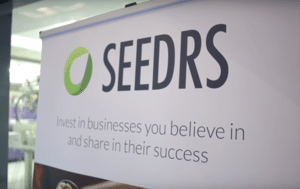 And where will Seedrs be in five years?
And where will Seedrs be in five years?
“I would like to be the largest private marketplace for equity investment. Our ambition is a global one,” says Kelisky.
Kelisky expects to operate in growing number of sectors and funding rounds across the finance ecosystem. Online has collided with offline and Seedrs can scale their services. In fact, Kelisky predicts Seedrs will be crowdfunding half a billion pounds by 2021. Now that is something to talk about.

